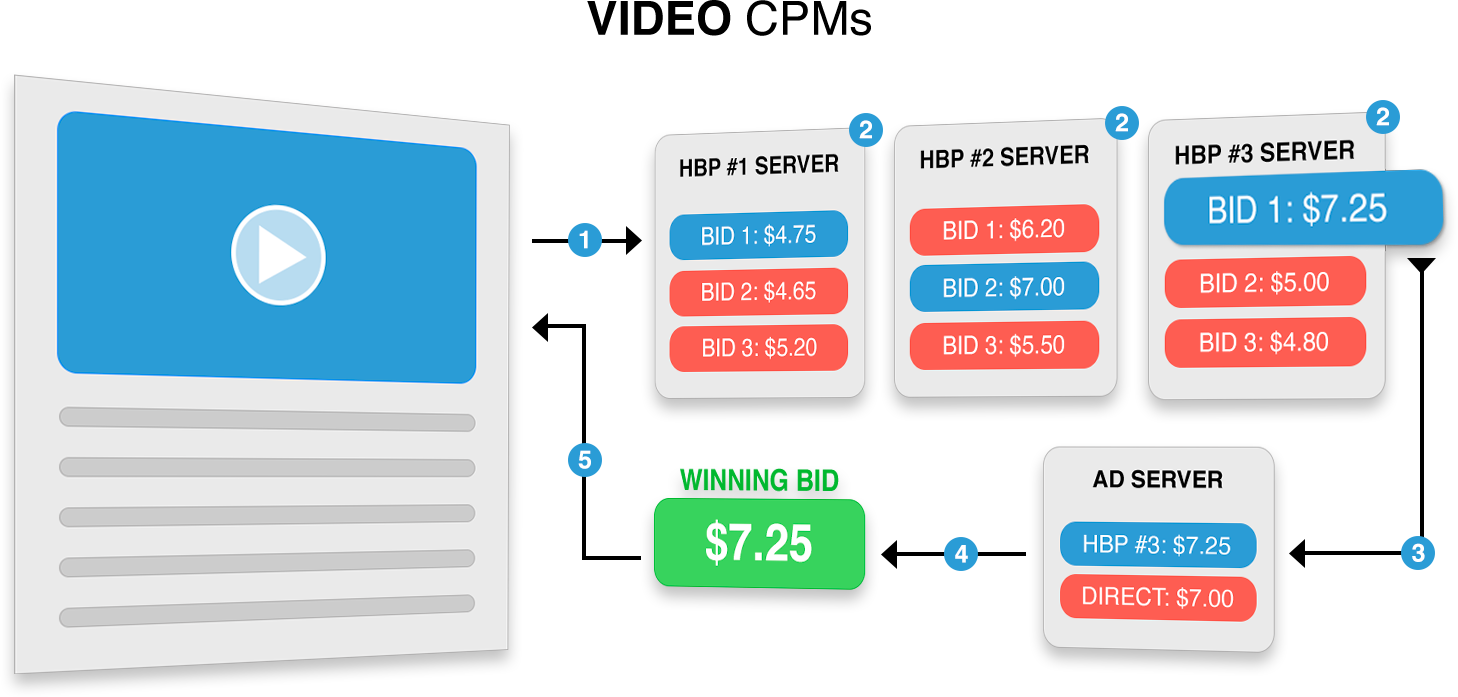Video Header Bidding: What Publishers Need to Know
March 16, 2022
Editorial Policy
All of our content is generated by subject matter experts with years of ad tech experience and structured by writers and educators for ease of use and digestibility. Learn more about our rigorous interview, content production and review process here.

In the digital ad space, video is a gold mine for publishers. As far back as 2008, when video advertising was relatively new, video cost per mille (CPM) rates were three times higher, on average, than display ad CPMs. In 2021, when 83.8% of the U.S. population watches digital video content at least once per month, the difference between video ad units and display ad units' CPMs is even more striking.
That probably explains why so many publishers are chomping at the bit to implement video advertising on their sites. What some of these publishers might not know, however, is that there's a way to make video even more valuable. It's called video header bidding.
Digital video has been around for a while, but video header bidding is a nascent technology in the ad tech space. In just two short years, video header bidding ad inventory has gained traction and taken off. Read on to learn everything publishers need to know about this new technology.
Playwire was one of the first platforms to implement video header bidding at scale. We've taken this tech to new heights with our revenue amplification platform for publishers. Want to get a piece of the action? Contact us.
-- Article Continues Below --
Read our complete guide to Header Bidding for everything you need to know.
How Video Header Bidding Increases Ad Revenue
This is the main thing publishers want to know: how does video header bidding help me earn more? It's all about the auction. Before header bidding, programmatic advertising used the waterfall auction method. Each bid request went to bidders one by one, moving down the list until someone made a bid that was higher than the price floor.
Header bidding for both video and display advertising turned that process on its head. Instead of a one-by-one auction, header bidding triggers a simultaneous auction. The bidders make their bids all at once with no knowledge of what the other bidders are offering. Then, the publisher gets the highest bid, rather than the first acceptable bid.
In other words, header bidding gets you the highest bid every single time. That way, you leave no ad revenue on the table.

Header Bidding for Video Ads: How it Works
If you're at all familiar with how header bidding works, you will have a pretty good idea of how video header bidding works. It's pretty much the same with only a few small differences. The key difference is that the Javascript that initiates the header bidding auction is usually embedded in your video player rather than the header of your site.
There are two types of header bidding for video: client-side and server-side.
Client-Side Video Header Bidding
In client-side video header bidding, the process begins when the video player on your site begins to load. That's when the script in the player sends the bid requests to your chosen ad exchanges and supply-side platforms (SSPs). There, buyers make simultaneous bids on your video inventory. Those bids return to your embedded header bidding wrapper, where they are evaluated and the best one is chosen.
The winning bid then goes to your ad server, where it competes with other demand sources, such as direct sales. The winner of that battle then gets the spot - the accompanying creative is served on your video player, and the user who initiated the process by loading your video player sees the ad.
Server-Side Video Header Bidding
Server-side video header bidding is almost identical to its client-side counterpart. The only real difference is that the auction, where the bids are evaluated, takes place on a dedicated ad server instead of within your header bidding wrapper on your site.
This method has quickly become more popular than client-side video header bidding because it can take some of the weight off of your site to maintain fast load times.
-- Article Continues Below --
The Guide to Video Ads for Web + App Publishers
Pros and Cons of Video Header Bidding
Let's be clear about something: video header bidding is good for publishers. The pros far outweigh the cons. However, if you do this the wrong way, you can open yourself up to some problems. Here are some of the pros and cons of video header bidding:
Pros
All the advantages of video header bidding for publishers have to do with earning more money. By bringing in higher CPMs and getting broader access to buyer demand, you get more.
- Higher ad revenue. When compared to using a waterfall approach, header bidding yields higher CPMs. The same is true for programmatic video vs. video header bidding. This higher revenue is the primary result of the way the auction works. Header bidding for video gives you access to the highest bid instead of just the first acceptable bid.
- Better access to demand. Another way video header bidding boosts your revenue has to do with access to demand. Instead of relying on a handful of demand partners, you can include as many demand partners as you want in your header bidding wrapper - and change them on the fly.
Those benefits are nothing to sneeze at, but this technology does come with some possible downsides.
Cons
There is no perfect ad tech innovation. No matter what new technology pops up for publishers to use, it's going to come with some possible problems, such as the following:
- Latency. Video players are notorious for slowing down web pages. Adding Javascript to one and facilitating a multi-call auction can make that problem even worse. If it takes too long for data to move across the ad network, you may get a timeout before you can serve a video ad to a viewer on your site. However, some innovators have solved this problem. Playwire's Trendi video player, for example, adds only a single line of code to your site.
- Data security. By definition, video header bidding causes your bid requests to go out to your entire demand network, as opposed to only a handful. That's a good thing, but it can lead to cookie data theft by bad actors on the buyer side. Playwire has solved this problem by maintaining a network of trusted and fully vetted demand partners who are here to buy ads, not steal data.
The video header bidding experts at Playwire have worked hard to build a platform that eliminates these problems for publishers. We give you all the benefits and none of the downsides.
Ready to Boost Your CPMs? Try Video Header Bidding with Playwire
Video ad CPMs are already high, but does that mean they shouldn't be higher? Personally, we think publishers should always get the highest possible revenue. To do that in 2021, you need to consider video header bidding.
At Playwire, we make video header bidding easy for publishers. With our comprehensive plug-and-play publisher revenue platform, all you have to do is sign up. We take it from there, and you have nothing left to do but sit back and watch the extra revenue pour in.
Does that sound like something you're ready for? If so, get in touch with our team; feel free to contact us online.

-1.png?width=800&height=157&name=1-playwire-logo-primary-2021%20(1)-1.png)





